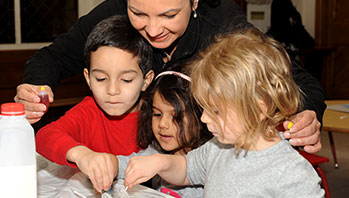- two plants of the same type
- difference
- similarity
MA Standards
English Language Arts/Language/L.PK.MA.6: Use words and phrases acquired through conversations, listening to books read aloud, activities, and play.
MA Draft Standards
Life Sciences/From Molecules to Organisms: Inheritance and Variation of Traits/LSI/3.A: Describe/draw and compare the body parts of animals (including themselves) and plants they are investigating [System] and explain functions of some of the observable body parts. [Structure and Function]
Life Sciences/From Molecules to Organisms: Inheritance and Variation of Traits/LSI/3.D: Recognize stages of the life cycle of plants and animals they have observed and discuss ideas about what happens at each stage. [Patterns, Change]
Life Sciences/From Molecules to Organisms: Inheritance and Variation of Traits/LSI/3.F: Identify similarities and differences among individuals of the same species. [Patterns]
Head Start Outcomes
Logic and Reasoning/Reasoning and Problem Solving: Classifies, compares, and contrasts objects, events, and experiences.
Science Knowledge/Scientific Skills and Method: Observes and discusses common properties, differences, and comparisons among objects.
PreK Learning Guidelines:
English Language Arts/Language 2: Participate actively in discussions, listen to the ideas of others, and ask and answer relevant questions.
Science and Technology/Inquiry Skills 4: Record observations and share ideas through simple forms of representation such as drawings.
Science and Technology/Life Sciences 10: Observe and identify the characteristics and needs of living things: humans, animals, and plants.
Science and Technology/Life Sciences 12: Observe and describe plants, insects, and animals as they go through predictable life cycles.
Small Group: Similarities and Differences

© Commonwealth of Massachusetts, Department of Early Education and Care (Jennifer Waddell photographer). All rights reserved.
STEM Key Concepts: Living things have similarities and differences; Living things exhibit diversity and variation; Living things have basic needs; Plants have different parts: roots, stems, leaves, and fruit
ELA Focus Skills: Listening and Speaking, Vocabulary
Continue the discussion that all living things have similarities and differences. Discuss how living things have basic needs, life cycles, diversity, and variation. Use two plants and two children to point out similarities and differences among all living things.
Direct attention to the two bean plants and ask questions such as,
- What is similar about these two bean plants? (leaves, roots, need water, etc.) What is different? (number of leaves, shape, size, etc.)
- What is different about the bean plants from when you first planted them? (growth, seed/plant, etc.)
Now, have two children stand up and ask the group questions such as,
- What is similar about these two children? (hair, two legs, etc.) Different? (eye color, size, etc.)
- What is different about children now from when they were babies? (growth, skills)
Then ask,
- What is something that is similar about plants and children? (need water and food; growth; characteristics vary in a group)
- What is something that is different? (don’t walk/ walk; roots/no roots)
Emphasize how both plants and children are living things. Then encourage children to draw a picture of two living things and show a similarity or a difference in them. Help them label their drawings.
